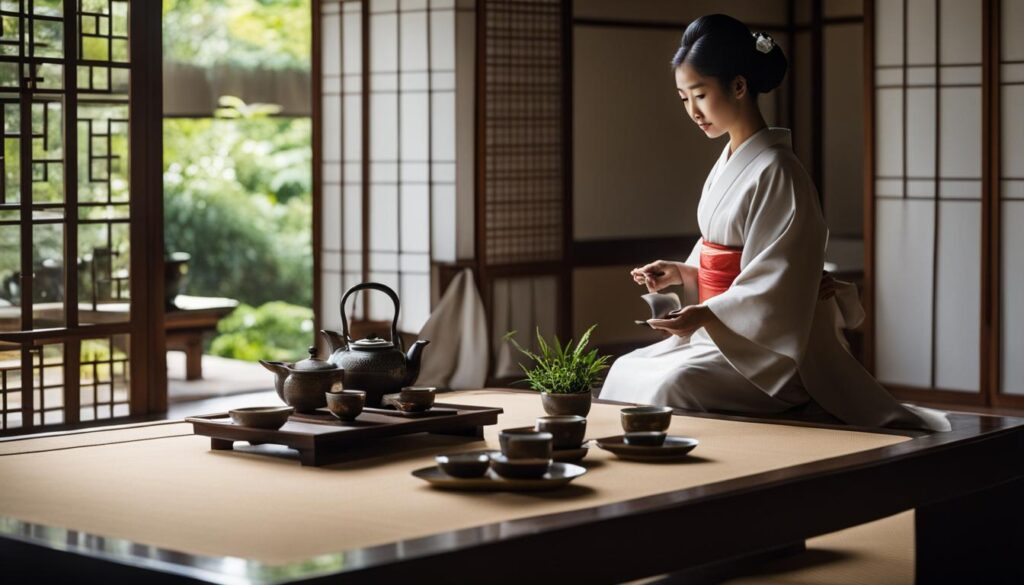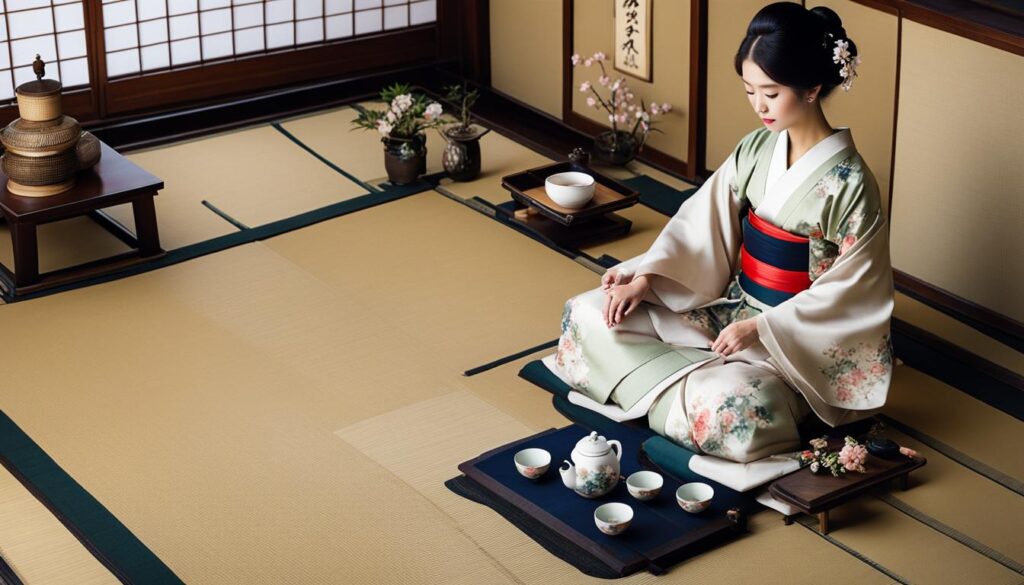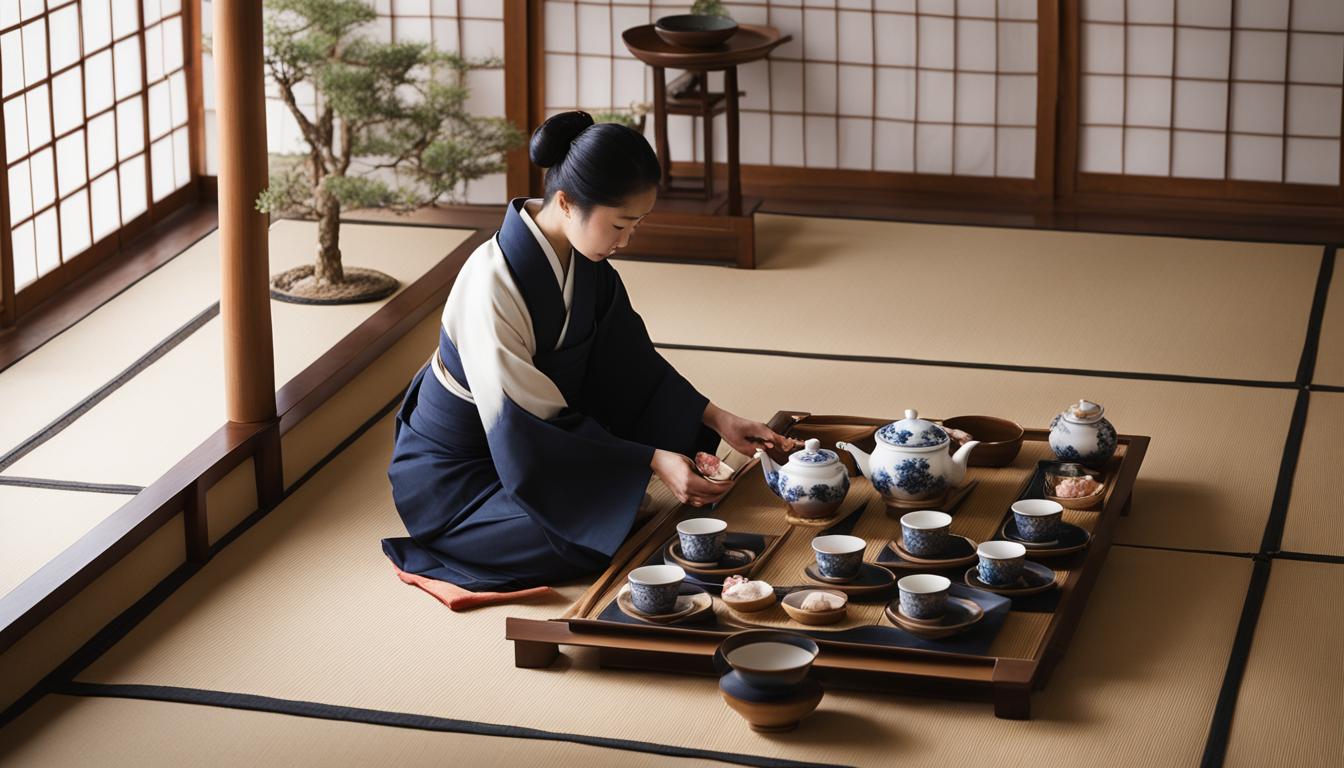Welcome to our comprehensive guide on mastering the art of traditional tea ceremony etiquette. From proper tea ceremony manners to tea ceremony social rules, we will take you on a journey through the rich traditions and customs of this beloved Japanese cultural activity. So, grab a cup of tea, sit back, and let’s explore the world of tea ceremony together.
Key Takeaways:
- Understanding the two main types of tea gatherings: chakai and chaji
- Exploring different types of Japanese tea ceremonies held for various occasions and seasons
- Discovering special occasion tea ceremonies that commemorate important events
- Learning tea ceremony etiquette and social customs for a harmonious experience
- Understanding seating and conversation etiquette during a tea ceremony
Different Types of Japanese Tea Ceremonies
The Japanese tea ceremony is a rich cultural practice that encompasses various types of tea gatherings. These gatherings offer participants unique experiences that showcase different aspects of Japanese culture. Apart from the main types of tea ceremonies, such as chakai and chaji, there are several other types held in Japan, each with its own distinctive atmosphere and traditions.
One such type is the Winter Dawn Tea Ceremony, known as Akatsuki-no-chaji. This ceremony is held in winter and takes place at dawn. It provides a serene and introspective experience, allowing participants to appreciate the stillness of the early morning and the tranquility of the winter season. The Winter Dawn Tea Ceremony is an opportunity for contemplation and reflection, as the participants immerse themselves in the beauty of the moment.
Another unique tea ceremony is the Early-Evening Tea Ceremony, called Yuuzari-no-chaji. This ceremony is held in the warmer months and takes place in the early evening. It offers a delightful blend of nature and relaxation, as participants enjoy the coolness of the evening breeze and the peaceful ambiance of a summer sunset. The Early-Evening Tea Ceremony is a rejuvenating experience that allows participants to unwind and appreciate the beauty of nature.
These different types of tea ceremonies provide participants with diverse experiences, each capturing a particular mood or season. Whether it’s the peacefulness of a winter dawn or the enchantment of a summer evening, each ceremony offers a glimpse into the intricate traditions and customs that make the Japanese tea ceremony a truly remarkable cultural practice.
Special Occasion Tea Ceremonies
Alongside the main types of tea ceremonies, there are also special occasions where unique ceremonies are held to commemorate significant events. These specialized tea ceremonies offer a deeper connection to traditional Japanese culture and provide participants with a chance to engage in specific customs and rituals.
One such special occasion tea ceremony is the Kuchikiri-no-chaji. This ceremony is conducted to honor the breaking of the seal on a jar of new tea, symbolizing the beginning of a new tea season. It signifies the freshness and anticipation that comes with the arrival of a new batch of tea leaves. Participants engage in a carefully choreographed series of movements and gestures, giving reverence to the tea and paying homage to the time-honored traditions surrounding its cultivation and preparation.
Another notable ceremony is the Nagori-no-chaji. This tea gathering is held to celebrate the transition into colder winter months and to bid farewell to the remaining tea from the previous year’s harvest. It serves as a reminder of the fleeting nature of the seasons and the importance of cherishing each moment. The Nagori-no-chaji is a poignant and reflective ceremony, allowing participants to appreciate the changing beauty of nature and the cyclical nature of life.

A Table Comparing Special Occasion Tea Ceremonies
| Ceremony | Purpose | Symbolism | Traditions |
|---|---|---|---|
| Kuchikiri-no-chaji | To honor the breaking of the seal on a jar of new tea | Beginning of a new tea season | Carefully choreographed movements and gestures |
| Nagori-no-chaji | To celebrate the transition into colder winter months and bid farewell to the last remains of the year’s tea supply | Transition and cyclical nature of seasons | Poignant and reflective ceremony |
“Tea ceremonies held for special occasions offer a unique opportunity to delve deeper into the rich traditions and customs of Japan. With each ceremony carrying its own significance and symbolism, participants are able to connect with the essence of Japanese culture and gain a profound understanding of the beauty and grace of the tea ceremony.”
Tea Ceremony Etiquette and Social Customs
In the Japanese tea ceremony, proper behavior and adherence to traditional practices are essential. The tea ceremony is not just a simple act of serving and drinking tea; it is a deeply rooted cultural experience that requires respect and harmony. Let’s explore some of the key etiquette and social customs that participants are expected to follow:
Proper Greeting and Phrases
When entering the tea room, it is customary to take off your shoes and bow as a form of greeting. This shows respect to the host and acknowledges the sacredness of the ceremony. Throughout the tea ceremony, participants use specific phrases like “Sumimasen” (excuse me) and “Arigato gozaimasu” (thank you) to show gratitude and respect. These phrases should be used genuinely and with sincerity.
Seating Arrangement and Order
The seating arrangement in a tea ceremony is carefully planned. The most honored guest is seated closest to the host, followed by other guests in a specific order. This seating arrangement reflects the hierarchical structure of the ceremony. It is important to follow the seating order and not to change seats unless directed by the host.
| Guest | Seating Order |
|---|---|
| Most honored guest | Closest to the host |
| Secondary guest | Second closest to the host |
| Other guests | Follow the order |
Attire and Dress Code
Participants in the tea ceremony are expected to dress formally and appropriately. Traditional attire like kimono or other traditional garments should be worn to show respect for the ceremony and its traditions. The clothing should be neat, clean, and in accordance with the solemnity and elegance of the tea ceremony.
“The tea ceremony is not only about drinking tea; it is an art of living that emphasizes respect and tranquility.” – Tea Master Soshitsu Sen XV
By following the tea ceremony etiquette and social customs, participants can fully appreciate the beauty and meaning behind this ancient practice. The tea ceremony is a profound experience that reflects the values and traditions of Japanese culture. Let us embrace the spirit of respect and harmony as we immerse ourselves in the world of tea.
Tea Ceremony Seating and Conversation Etiquette
In a traditional Japanese tea ceremony, seating arrangement and conversation etiquette are essential aspects that contribute to the overall atmosphere and experience. Guests are usually seated in a specific order, with the most honored guest sitting closest to the host. This seating arrangement reflects the hierarchical nature of the ceremony and shows respect for the guests and the host.
During the ceremony, guests are expected to engage in polite and respectful conversation. It is important to avoid contentious or controversial topics that may disrupt the harmony and tranquility of the ceremony. Instead, focus on light-hearted and pleasant discussions that contribute to the serene ambiance.
As a guest, it is customary to express gratitude and appreciation for the tea and the host’s efforts. A simple phrase like “Oishii ocha desu!” meaning “The tea is delicious!” is often used to convey enjoyment and appreciation. By following these seating and conversation etiquette, guests can fully immerse themselves in the tea ceremony experience.
Table: Tea Ceremony Seating Order
| Seating Order | Description |
|---|---|
| Shokyaku | The most honored guest seated closest to the host |
| Jikyaku | Guests of lesser honor seated farther from the host |
| Shokyaku no ko | Assistant to the most honored guest, seated next to the Shokyaku |
| Tsume | Guests seated closest to the entrance |
“The tranquility of the tea ceremony allows for meaningful connections and a deep sense of appreciation for the moment. By adhering to the seating order and engaging in respectful conversation, guests contribute to the overall harmony of the ceremony.”
Tea Ceremony Attire and Dress Code
When participating in a traditional Japanese tea ceremony, it is essential to adhere to the appropriate attire and dress code. The attire chosen for this occasion should reflect the solemnity and elegance of the ceremony. Traditional clothing such as kimono or other traditional garments is commonly worn to honor the tea ceremony’s rich cultural heritage.

Wearing traditional tea ceremony attire not only shows respect for the ceremony and its traditions but also allows participants to fully immerse themselves in the experience. The clothing should be neat, clean, and well-maintained, enhancing the overall atmosphere of the tea ceremony. It is essential to choose attire that is appropriate for the occasion and follows the dress code set by the host.
Dress Code Guidelines for Tea Ceremony Attire:
- Opt for traditional clothing such as kimono or other traditional garments.
- Ensure the clothing is clean, well-maintained, and free from wrinkles.
- Choose appropriate colors for the season or occasion.
- Avoid loud or flashy patterns that may distract from the tea ceremony’s serene ambiance.
- Follow the guidance and instructions provided by the host regarding specific dress requirements.
By observing the dress code and wearing traditional tea ceremony attire, participants contribute to the overall harmonious and respectful atmosphere of the ceremony. This attention to detail adds to the authenticity and beauty of the tea ceremony experience.
Tea Ceremony Practical Tips and Customs
As you prepare to immerse yourself in the beauty and tranquility of a Japanese tea ceremony, it’s helpful to familiarize yourself with some practical tips and customs. These insights will enhance your experience and ensure that you navigate the ceremony with grace and respect.
Arrive On Time and Bring a Gift
Etiquette dictates that you arrive on time or slightly early for a tea ceremony. Punctuality is highly valued and demonstrates your respect for the host and the ceremony itself. In addition to being on time, it is also customary to bring a small gift or token of appreciation for the host. This gesture shows gratitude for their efforts in organizing the ceremony and adds an extra touch of thoughtfulness to the occasion.
Adhere to Tea-Drinking Customs
During the tea ceremony, there are specific customs related to drinking the tea. When receiving the tea bowl, hold it with both hands as a sign of respect. Take small, respectful sips of the tea instead of gulping it down quickly. Savor each sip and appreciate the flavors and the experience of the moment. By following these tea-drinking customs, you will fully embrace the tradition and the spirit of the ceremony.
Another delightful aspect of the tea ceremony is the serving of traditional sweets, known as wagashi. These confections are carefully crafted to complement the flavors of the tea and provide a delightful balance of taste and texture. Enjoy these sweets with gratitude, savoring each bite as an integral part of the overall experience.
Dress Code and Attire
The tea ceremony is a formal and solemn occasion, and as such, there is a specific dress code to adhere to. Traditional attire such as a kimono or other appropriate garments should be worn to show respect for the ceremony and its traditions. Ensure that your clothing is neat, clean, and respectful, reflecting the solemnity and elegance of the occasion. By dressing appropriately, you contribute to the harmony and reverence of the tea ceremony.
In conclusion, by following these practical tips and customs, you will fully appreciate the essence of a Japanese tea ceremony. Arriving on time, bringing a small gift, adhering to tea-drinking customs, and dressing appropriately all contribute to creating a harmonious and respectful atmosphere. So, breathe deeply, savor each sip, and embrace the tranquility and grace of this timeless tradition.
Conclusion
We’ve delved into the fascinating world of the Japanese tea ceremony, a tradition that embodies the essence of Japanese culture. Through the careful observance of tea ceremony etiquette and customs, participants can not only indulge in the art of tea preparation and presentation but also experience a profound sense of harmony and respect.
From the various types of tea ceremonies, including the informal chakai and the formal chaji, to the special occasions commemorated through ceremonies like Kuchikiri-no-chaji and Nagori-no-chaji, each gathering provides a unique glimpse into Japanese customs and traditions.
Understanding the importance of proper seating, polite conversation, and appropriate attire allows us to fully immerse ourselves in the solemnity and elegance of the tea ceremony. By following these customs, we can show our deep respect for the ceremony and its cultural significance.
So, whether you’re attending a morning Asa-cha or an evening Yuuzari-no-chaji, remember to arrive on time, bring a small token of appreciation for the host, and savor the tea in small, respectful sips. The Japanese tea ceremony is a timeless practice that not only offers a delightful sensory experience but also serves as a bridge to connect with the rich cultural heritage of Japan.
FAQ
What is the Japanese tea ceremony?
The Japanese tea ceremony, also known as chanoyu or sadō, is a cultural activity that involves the ceremonial preparation and presentation of matcha, powdered green tea.
What are the main types of tea gatherings in a Japanese tea ceremony?
There are two main types of tea gatherings: an informal tea gathering called chakai, and a formal tea gathering called chaji.
What is the difference between chakai and chaji?
Chakai is a simpler gathering that includes sweets and thin tea, while chaji is more formal and includes a full-course meal followed by sweets, thick tea, and thin tea.
Are there other types of tea ceremonies held in Japan?
Yes, there are various other tea ceremonies held in Japan for different occasions, seasons, and times of day.
Can you give some examples of other types of tea ceremonies?
Some examples include the Akatsuki-no-chaji, a dawn tea ceremony held in winter; the Yuuzari-no-chaji, an early-evening tea ceremony in the warmer months; and the Asa-cha, an early-morning summer tea ceremony.
Are there tea ceremonies held for special occasions?
Yes, there are certain tea ceremonies held to commemorate special occasions, such as the breaking of the seal on a jar of new tea or the transition into colder winter months.
What are the etiquette and social customs in a Japanese tea ceremony?
Participants are expected to follow certain etiquette, such as taking off shoes at the entrance, bowing as a form of greeting, and using specific phrases to show respect and gratitude.
How does seating arrangement and conversation etiquette work in a tea ceremony?
Guests are typically seated in a specific order, with the most honored guest sitting closest to the host. During the ceremony, guests should engage in polite and respectful conversation, avoiding any contentious or controversial topics.
What is the traditional attire for a tea ceremony?
Traditional tea ceremony attire typically consists of kimono or other traditional garments. Participants are expected to wear formal and appropriate clothing that reflects the solemnity and elegance of the tea ceremony.
Are there any practical tips for a tea ceremony?
It is considered polite to arrive on time or slightly early to the ceremony and to bring a small gift or token of appreciation for the host. Participants should also follow proper tea-drinking customs, such as holding the tea bowl with both hands and sipping the tea in small, respectful sips.
What is the significance of the Japanese tea ceremony?
The Japanese tea ceremony is a deeply rooted tradition that showcases the culture of Japan. It is not just a simple act of serving and drinking tea, but a profound experience that encompasses etiquette, harmony, and respect.





